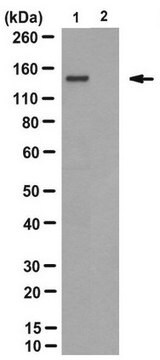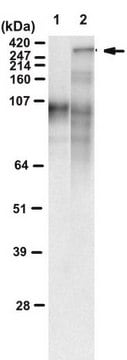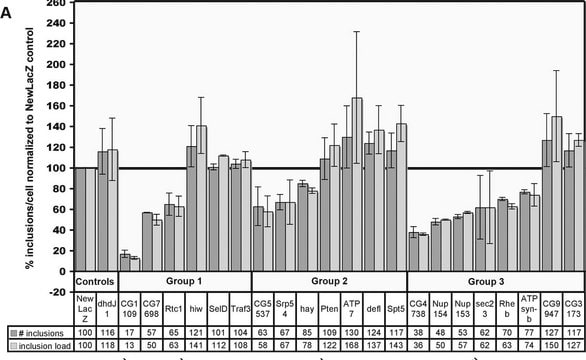MAB2166
Anti-Huntingtin Protein Antibody, a.a. 181-810, clone 1HU-4C8
ascites fluid, clone 1HU-4C8, Chemicon®
Sinônimo(s):
Huntingtin, Huntington′s Disease Protein, HD Protein
About This Item
Produtos recomendados
fonte biológica
mouse
Nível de qualidade
forma do anticorpo
ascites fluid
tipo de produto de anticorpo
primary antibodies
clone
1HU-4C8, monoclonal
reatividade de espécies
rat, rabbit
reatividade da espécie (prevista por homologia)
mouse, human, hamster, monkey
fabricante/nome comercial
Chemicon®
técnica(s)
ELISA: suitable
immunocytochemistry: suitable
immunohistochemistry: suitable (paraffin)
immunoprecipitation (IP): suitable
western blot: suitable
Isotipo
IgG1κ
nº de adesão NCBI
nº de adesão UniProt
Condições de expedição
dry ice
modificação pós-traducional do alvo
unmodified
Informações sobre genes
human ... HTT(3064) , SLC6A4(6532)
Descrição geral
Especificidade
Imunogênio
Aplicação
A 1:500-1:5,000 dilution of a previous lot was used on ELISA.
Immunohistochemistry:
A 1:500-1:5,000 dilution from a previous lot was used on frozen and microwave oven treated paraffin sections (human tissue).
Immunocytochemistry:
1:500-1:5,000 on a previous lot was used on transfected cells.
Immunoprecipitation:
A 1:500-1:5,000 dilution of a previous lot was used on immunoprecipitation.
Western blot:
1:500-1:5,000. Should detect a band migrating at approximately 350-400 kDa by Western blot (Nature Genetics 10:104-110.).
Optimal working dilutions must be determined by the end user.
Neuroscience
Neurodegenerative Diseases
Qualidade
Western Blot Analysis:
1:1000 dilution of this lot detected huntingtin protein on 10 μg of rat brain lysates.
Descrição-alvo
forma física
Armazenamento e estabilidade
Handling Recommendations: Upon receipt, and prior to removing the cap, centrifuge the vial and gently mix the solution. Aliquot into microcentrifuge tubes and store at -20°C. Avoid repeated freeze/thaw cycles, which may damage IgG and affect product performance.
Nota de análise
Normal human cerebral cortex lysate
Outras notas
Informações legais
Exoneração de responsabilidade
Not finding the right product?
Try our Ferramenta de seleção de produtos.
recomendado
Código de classe de armazenamento
12 - Non Combustible Liquids
Classe de risco de água (WGK)
WGK 2
Ponto de fulgor (°F)
Not applicable
Ponto de fulgor (°C)
Not applicable
Certificados de análise (COA)
Busque Certificados de análise (COA) digitando o Número do Lote do produto. Os números de lote e remessa podem ser encontrados no rótulo de um produto após a palavra “Lot” ou “Batch”.
Já possui este produto?
Encontre a documentação dos produtos que você adquiriu recentemente na biblioteca de documentos.
Os clientes também visualizaram
Artigos
Immunofluorescence uses antibody-conjugated fluorescent molecules for protein localization, modification confirmation, and protein complex visualization.
Protocolos
Tips and troubleshooting for FFPE and frozen tissue immunohistochemistry (IHC) protocols using both brightfield analysis of chromogenic detection and fluorescent microscopy.
Nossa equipe de cientistas tem experiência em todas as áreas de pesquisa, incluindo Life Sciences, ciência de materiais, síntese química, cromatografia, química analítica e muitas outras.
Entre em contato com a assistência técnica







